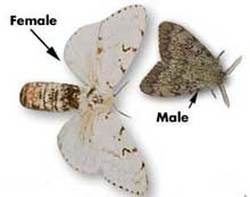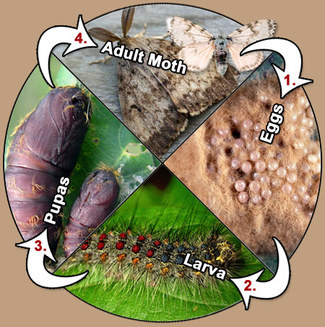The gypsy moth has been a major pest in the northeastern United States for centuries. Back in 1869 the moths were brought here to start a silkworm industry, and managed to escape captivity soon after.

Egg masses appear as 1.5 inch tan colored hairs on tree trunks. Males are grayish brown and can fly. Females are larger and white with black marks but cannot fly.
The gypsy moth caterpillar has a preference for the leaves of deciduous hardwood trees such as maple, elm, and particularly oak. Gypsy moths can also feed on apple, alder, birch, poplar, and willow trees. As it grows it will also attack evergreens like pines and spruces. Gypsy moths appear to dislike ashes, sycamores, butternuts, black walnuts, dogwoods and balsams. However, during heavy infestations, competition for food will drive the caterpillar to attack almost any tree or shrub.
Most deciduous trees can survive a moderate degree of defoliation. Many can even survive a complete defoliation by the gypsy moth caterpillar. However, continuing attacks can fatally weaken a tree or leave it vulnerable to other insects or disease.
Egg masses appear as 1.5 inch tan colored hairs on tree trunks. Males are grayish brown and can fly. Females are larger and white with black marks but cannot fly.
The gypsy moth caterpillar has a preference for the leaves of deciduous hardwood trees such as maple, elm, and particularly oak. Gypsy moths can also feed on apple, alder, birch, poplar, and willow trees. As it grows it will also attack evergreens like pines and spruces. Gypsy moths appear to dislike ashes, sycamores, butternuts, black walnuts, dogwoods and balsams. However, during heavy infestations, competition for food will drive the caterpillar to attack almost any tree or shrub.
Most deciduous trees can survive a moderate degree of defoliation. Many can even survive a complete defoliation by the gypsy moth caterpillar. However, continuing attacks can fatally weaken a tree or leave it vulnerable to other insects or disease.
Location |
|
